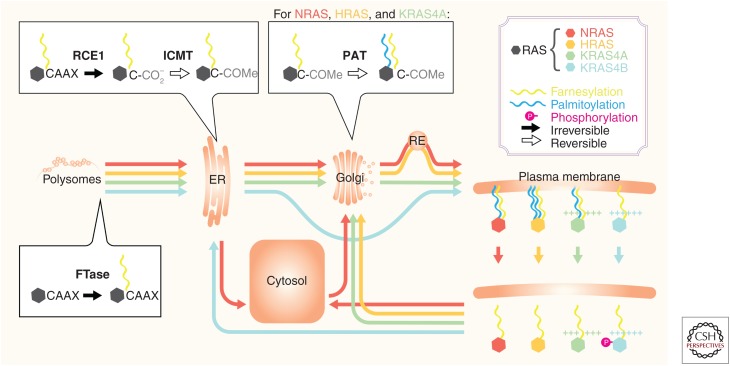Figure 1.
Differential posttranslational processing regulates RAS isoform subcellular trafficking. The trafficking of RAS isoforms HRAS, NRAS, KRAS4A, and KRAS4B (color coded, see legend) are schematized for the nascent proteins following messenger RNA (mRNA) translation on polysomes in the cytosol. The enzymes that catalyze the posttranslational modifications (PTMs) that direct trafficking are highlighted in dialog boxes (FTase, farnesyltransferase; RCE1, Ras-converting enzyme 1 protease; ICMT, isoprenylcysteine carboxylmethyltransferase; PATs, DHHC family of palmitoyl acyl transferases) with irreversible modifications (farnesylation and proteolysis) indicated by solid arrows, and reversible modifications (carboxyl methylation, palmitoylation, and phosphorylation) indicated by outlined arrows (see legend). Lipid modifications (farnesylation and palmitoylation) are color coded (see legend). The subcellular locations at which these modifications occur (ER, endoplasmic reticulum; Golgi, Golgi apparatus; RE, recycling endosome; cytosol, plasma membrane) are also indicated. Between the indicated subcellular compartments, the color-coded arrows denote both the RAS isoform undergoing transit and the direction of trafficking. For KRAS4A and KRAS4B, (+) signs indicate polybasic residues that confer electrostatic affinity for phospholipid headgroups, which, in the case of KRAS4B, is interrupted by phosphorylation (via protein kinase C [PKC] and GMP-dependent protein kinase 2 [PKG2] as discussed in the text but not depicted here). For NRAS, arrows indicate transit to the cytosol, a compartment in which this isoform accumulates when unpalmitoylated, from both the ER and plasma membrane. Prenyl-dependent chaperone interactions for N/KRAS with PDE6δ or for NRAS with VPS35 are not depicted but are discussed in the text.

